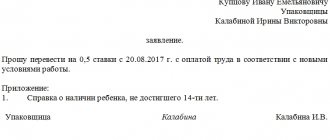The concept of a six-day working week, legislative framework
Chapter 16 of the Labor Code of the Russian Federation provides for the establishment of working hours. There is no precise definition of this concept in the legislation, however, Article 100 of the Labor Code of the Russian Federation states that the working time regime must take into account the following nuances:
- length of the work week (five-day work week with two days off, six-day work week with one day off, or work on a rotating schedule);
- irregular working hours for certain categories of workers;
- time of arrival and departure from work, including breaks;
- change of working days and days off in accordance with labor legislation, collective and labor agreements.
Regardless of work mode, the working week should not exceed 40 hours in total. However, there is an exception when a summary recording of working time is carried out - the norm of working time for a certain period (month, quarter, year) is observed.
This option is used if it is impossible to comply with the stipulated daily or monthly working hours. An organization can use a single operating mode (a five-day work week) or simultaneously use several modes (for example, one group works a five-day week with sliding days off, another group works a six-day week with one day off).
The procedure for establishing a 6-day week and the transition from a five-day week
The working hours, which include a six-day or five-day schedule, are an essential working condition that every employee must be familiar with before signing an employment contract.
The specified routine is necessarily fixed in the local acts of the enterprise - the collective labor agreement and the internal labor regulations.
Due to changes in production, it may be necessary to change the work schedule from a five-day to a six-day work week.
The submitted changes are formalized by issuing an order by the head of the organization in accordance with the regulated procedure.
The order, as well as the new schedule and internal labor regulations, must be developed no later than 2 months before the innovation comes into force.
After the order is issued, it should be familiarized with it against signature of each employee who gives written consent to work under the updated regime or refuse to switch to a six-day regime with further termination of the employment contract.
Due to the fact that the amendments may entail mass layoffs, the employment service is notified of the transition to a six-day schedule.
An additional agreement to the employment contract is signed with employees who give written consent to work according to the new schedule.
Sample order
The order to switch to a six-day working week is issued in accordance with the basic requirements of office work.
The submitted document must specify the reason why production is forced to increase the number of working days, and also specify the daily number of working days, days off, and break time.
The specified administrative document is signed by the manager, as well as by officials who are directly affected by the order (on familiarization of employees, on concluding additional agreements, on new payroll calculations, etc.).
order to switch to a six-day week from a five-day week - word.
Features of a six-day work week compared to a five-day schedule
Article 111 of the Labor Code of the Russian Federation states that with a five-day working week there are two days off, and with a six-day week - one. The second day off during a five-day week is established in a collective agreement or in accordance with internal regulations, and Sunday is considered a general day off.
According to the rules, the length of the working day before a holiday is reduced by one hour. According to Article 95 of the Labor Code of the Russian Federation, with a six-day working week, the duration of work on such days cannot exceed five hours.
It is worth noting that if a weekend and a non-working holiday coincide, the first is transferred to the next working day after the holiday. Exceptions to this rule are the New Year holidays and Christmas (Part 2 of Article 112 of the Labor Code of the Russian Federation). In this case, two days off that coincided with these holidays are transferred to other days in the next calendar year.
This rule of transferring a day off that coincides with a holiday to the next working day also applies to regional holidays (Minutes No. 1 of 06/02/2014)
It is worth mentioning the length of a typical working day. With a five-day working week, it is eight hours; with a six-day working week, the number of hours per day is not clearly established, however, in practice, five days of seven hours are often set, and the sixth is five.
The nuances of work on a six-day schedule under different working conditions
Irregular working hours, in accordance with the Labor Code of the Russian Federation, provide that, by order of the employer, individual employees may be involved in performing their job duties beyond the established working hours. However, such a regime can only be applied to those employees whose collective bargaining agreement or agreement contains a list of job descriptions adopted taking into account the representative body of employees.
The employee's consent to the use of such a regime is not required.
A flexible work schedule, according to Part 1 of Article 102 of the Labor Code of the Russian Federation, is an organization of working time when the beginning, end or duration of working time is established by agreement of the parties to the employment contract. In this mode, daily or monthly working hours cannot be met, so summarized working time recording is used.
The employer, in this case, must ensure that the employee works the total number of working hours during a certain accounting period.
Shift work is established when the duration of the production process is higher than the permissible norm. This mode is used for more rational use of equipment, as well as increasing the volume of products or services provided. In accordance with Article 103 of the Labor Code of the Russian Federation, each group of workers must perform their labor duties during the time established in the shift schedule.
In some types of production with unequal intensity of work throughout the working day, according to Article 105 of the Labor Code of the Russian Federation, the working day can be divided into parts. Labor legislation does not regulate their duration and quantity. The only condition remains compliance with the limits of the total working time and the prescribed duration of daily work.
Internal labor regulations are a local regulatory act that regulates hiring, dismissal, rights, duties and responsibilities of the parties, work and rest hours, types of incentives and penalties applied to the employee, as well as other issues regulating labor relations (Article 189 of the Labor Code of the Russian Federation) .
How the six-day period is used in various work regimes
Labor legislation includes the concept of irregular working hours. This regime implies the involvement of some employees in the performance of professional duties in excess of the standard working hours. It is allowed to apply an irregular day only to those employees and categories whose labor or collective agreement includes information about this, as well as a list of job obligations and instructions. The process of adopting this list must involve the participation of a trade union representing the interests of workers.
On a note! The employee’s separate consent to use an irregular schedule is not required if this rule is specified in the agreements signed by the employee.
The flexible work schedule, regulated by Part 1 of Article No. 102 of the Labor Code, implies a form of distribution of working time in which the beginning and end of the working day, as well as its duration, are agreed upon by both parties to the labor relationship.
This organization of the labor process does not imply compliance with daily, weekly and monthly working hours. In this case, the total calculation of labor hours for the period is used.
On a note! With a flexible schedule, the employer has the obligation to ensure that hours are worked within a specified time period that is subject to accounting.
A shift schedule is used in cases where the duration of the production process exceeds the established maximum standards. In order to rationally use production resources, including energy and machine resources, as well as to increase the efficiency of the work process, a shift mode of operation of the enterprise is established. According to the provisions of Article No. 103 of the Labor Code, all groups of employees perform their professional duties during their shift, the time and duration of which are indicated in the production shift schedule.
In certain production sectors with varying degrees of load intensity during the working day, the possibility of dividing the day into parts is allowed. This point is indicated in Article No. 105 of the Labor Code. The duration and number of such segments are not regulated. The only applicable regulatory requirement is that total working hours comply with legal limits.
Important
In accordance with the provisions of Article No. 189 of the Labor Code, the procedure for employment, dismissal, hourly distribution of time, the ratio of working days and weekends, the rights and obligations of the hired and hiring parties, as well as the categories of incentive and penalty measures used in relation to employees in established situations are regulated by enterprise internal labor regulations - a specialized document-regulatory act for internal use.
Standard hours for a six-day work week
According to Article 100 of the Labor Code of the Russian Federation, one day off is established for enterprises and organizations with a six-day working week. The general day off is Sunday (Article 111 of the Labor Code of the Russian Federation).
The normal duration of a six-day working week, like a five-day one, cannot be more than 40 hours (Article 91 of the Labor Code of the Russian Federation).
The standard working time for a six-day work week is calculated according to the calculated schedule of a five-day work week. Thus, the standard working hours in both cases are the same.
Calculation of working time standards in 2020 is carried out depending on the duration of the work shift:
- with a 40-hour work week – 8 hours;
- if the working week is less than 40 hours - the number of hours that is obtained by dividing the established working week by five.
The absence of postponements of weekends due to holidays does not in any way affect the procedure for calculating time standards, since they are calculated based on a five-day week.
Therefore, the working time standards for a six-day working week are:
- at 40 hours – 1970 hours (40 hours: 5 days × 247 days – 6 hours);
- at 36 hours – 1772.4 hours (36 hours: 5 days × 247 days – 6 hours);
- at 24 hours – 1179.6 hours (24 hours: 5 days × 247 days – 6 hours).
Standard working hours (hours)
| 40 hour work week | 184 |
| 36 hour work week | 165.6 |
| 24 hour work week | 110.4 |
Examples
| 40 hour work week | 160 |
| 36 hour work week | 144 |
| 24 hour work week | 96 |
| 40 hour work week | 176 |
| 36 hour work week | 158.4 |
| 24 hour work week | 105.6 |
| 40 hour work week | 167 |
| 36 hour work week | 150.2 |
| 24 hour work week | 99.8 |
Production calendar for 2020 (6-day work week)
The following non-working holidays are established in Russia (Article 112 of the Labor Code of the Russian Federation):
- January 1, 2, 3, 4, 5, 6 and 8 — New Year holidays;
- January 7—Christmas Day;
- February 23 - Defender of the Fatherland Day;
- March 8—International Women's Day;
- May 1 - Spring and Labor Day;
- May 9 - Victory Day;
- June 12—Russia Day;
- November 4 is National Unity Day.
Weekends may be transferred to other days by federal law or a regulatory legal act of the Government of the Russian Federation (Part 5 of Article 112 of the Labor Code of the Russian Federation).
In 2020, the following transfers of weekends are provided (Government Decree No. 1250 dated October 14, 2017):
- from Saturday 6 January to Friday 9 March;
- from Sunday January 7 to Wednesday May 2;
- from Saturday 28 April to Monday 30 April;
- from Saturday 9 June to Monday 11 June;
- from Saturday 29 December to Monday 31 December.
At the same time, Saturdays April 28, June 9 and December 29 will be shortened by 1 hour according to the “pre-holiday” principle. If, in accordance with a government decision, a day off is transferred to a working day, the duration of work on this day (in this case, Saturday) must correspond to the duration of the working day to which the day off was transferred (clause 1 of the Procedure for calculating working time norms, approved by order of the Ministry of Health and Social Development of the Russian Federation dated August 13, 2009 No. 588n).
Taking this into account, we rest like this:
- The New Year holidays will last 10 days - from December 30, 2020 to January 8, 2020;
- On Defender of the Fatherland Day we will rest for 3 days - from February 23 to 25;
- on International Women's Day 4 days - from March 8 to 11;
- in May we will rest for 4 days in honor of the Spring and Labor Festival - from April 29 to May 2;
- there will be another day off on May 9 in honor of Victory Day;
- Russia Day will be marked by three weekends - from June 10 to 12;
- On National Unity Day we will also have a 3-day holiday - from November 3 to 5;
- Saturday, December 29th will have to be worked, but Monday, December 31st will be a day off.
In the Republic of Crimea, by special resolution of the head of Crimea, additional days off were approved:
- March 18 is the Day of the reunification of Crimea with Russia;
- April 17, 2020 - Easter;
- May 28, 2020 - Trinity;
- June 15, 2020 – Eid al-Adha;
- August 22, 2020 – Eid al-Adha
Calculation of standard working hours
The standard working time for certain periods (month, quarter, year) is calculated as required by Art. 91 of the Labor Code of the Russian Federation and in accordance with Order No. 588n.
So, the norm for a particular month is calculated as follows:
the length of the working week (40, 36, 24, other number of hours) is divided by 5, multiplied by the number of working days according to the calendar of the 5-day working week of this month and from the resulting number of hours the number of hours in this month for which work is carried out is subtracted reduction of working hours on the eve of non-working holidays.
Important! The standard working time calculated in this manner applies to a 6-day working week.
Thus, when drawing up a monthly schedule for a 6-day week, it is necessary to ensure that not only the weekly limit (40-, 36-, 24-hour) is observed, but also that the total number of working hours does not exceed the monthly norm calculated in the specified above order.
Six-day production calendar
When recording working time in aggregate, the hours worked by an employee must be calculated in total in relation to the accounting period. Overtime is considered to be hours worked by an employee in excess of the established working hours for the accounting period.
For overtime hours of work, employees are entitled to an additional payment of no less than one and a half times for the first two hours of overtime work, and double for subsequent ones (Article 152 of the Labor Code of the Russian Federation). Example: suppose you have set up a summarized work time tracking with an accounting period equal to a month. According to the time sheet, the employee worked 165 hours in November 2020.
The standard working time for November 2020 according to the production calendar is 159 hours. 165-159=6 hours of overtime.
How to convert to a six-day work week?
The norm of working time for the year as a whole is calculated in a similar manner: the length of the working week (40, 39, 36, 30, 24, etc.
hours) is divided by 5, multiplied by the number of working days according to the calendar of a five-day working week in a year, and from the resulting number of hours the number of hours in a given year by which working hours are reduced on the eve of non-working holidays is subtracted. The specified Procedure is used to guide the preparation of the production calendar.
As you can note, this Procedure is designed for a five-day working week, and for a six-day week, the procedure for calculating the standard hours is limited by the norms of the Labor Code of the Russian Federation on a 40-hour working week, postponing holidays and shortening pre-holiday days, days off on Sunday and five hours of work on Saturday.
Six day work week
Question There are engineers on staff who have a traveling nature of work and a 5-day working week. We want to transfer them to a 6-day working week, traveling nature of work with flexible working hours.
Can we switch to this work schedule according to the Labor Code? If so, how will they pay for overtime, using the example in numbers? Answer Answer to question: Yes, you can switch employees to a six-day work week with flexible working hours.
It should be taken into account that since a working mode that differs from the general one for the organization is a mandatory condition of the employment contract, its change must be formalized by an additional agreement to the employment contract. As a general rule, such changes are allowed only with the written consent of the employee (Art.
72 of the Labor Code of the Russian Federation).
Error 404
Attention
For some categories of employees, a separate procedure for applying the flexible working time regime is provided.
In particular, this procedure has been established: Establishing a flexible working time regime in a department How to establish a flexible working time regime in a department of an organization To introduce such a regime for certain categories of employees, for example, an entire division of an organization, specify the application of the flexible working time regime in the Labor Regulations (Part.
1 tbsp. 100, part 4 art. 189
Labor Code of the Russian Federation). Establish a summarized accounting of working hours for employees working in flexible working hours, if the daily or weekly working hours provided for this category of employees cannot be observed (Part 1 of Article 104 of the Labor Code of the Russian Federation). The procedure for applying summarized accounting is specified in the Labor Regulations (Part.
3 tbsp. 104 Labor Code of the Russian Federation).
Order establishing a six-day working week
Important
Depending on production conditions, some enterprises and organizations may establish a six-day working week when carrying out activities for their employees (all or certain categories).
sample order for transition to a six-day work week
This working time regime - a six-day work week with one day off - is applicable under the terms of Art.
100 This limitation is established by Art. 91 Labor Code of the Russian Federation. In turn, Art. 95 of the Labor Code of the Russian Federation establishes that the duration of the working day or shift immediately preceding a non-working holiday is reduced by one hour. This provision applies equally to both a five-day work week and a six-day work week.
About the six-day work week
To introduce such a regime for certain categories of employees, for example, an entire division of an organization, specify the application of the flexible working time regime in the Labor Regulations (Part 1 of Article 100, Part 4 of Article 189 of the Labor Code of the Russian Federation).
With employees switching to a six-day work week and a flexible schedule, enter into additional agreements to employment contracts and issue an order in any form.
Establish a summarized accounting of working hours for employees working in flexible working hours, if the daily or weekly working hours provided for this category of employees cannot be observed (Part 1 of Article 104 of the Labor Code of the Russian Federation). The procedure for applying summarized accounting is specified in the Labor Regulations (Part.
3 tbsp. 104 Labor Code of the Russian Federation).










